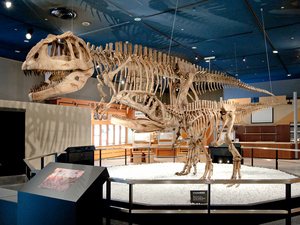Nagoya City Science Museum
TOP > Exhibition Guide > Keyword Search > Starting with "M" > Maupusaurus > "Mapusaurus roseae" (Reconstructed skeleton)
"Mapusaurus roseae" (Reconstructed skeleton)



Purpose of Exhibition
Dinosaurs attract many people. Probably, this is because the large animals is not fantasy with undoubted evidence of the existence in the past long before humans walked on the earth. To inspire a deepeer interest in palaeontology, the reconstructed skeltons are displayed with some related fossil specimens.
Additional Knowledge
Tyrannosaurus? The skulls, large jaws with steak knife and jagged teeth, and sharp claws look like a Tyrannosaurus. But it is not! This is a "Mapusaurus", which means "Earth lizard".They have slightly longer faces than a Tyrannosaurus. Because it was just named in 2007, it has not appeared in any movies. Other than dinosaur fans, few know its name. On the other hand, it was used in the filming of the television drama "Galileo" (2013), so it may be gaining a bit of fame. The Mapusaurus was a typical meat eating (carnivorous) dinosaur. It lived in the Gondwana supercontinent which existed in the southern hemisphere approximately 100 million years ago during the Cretaceous period, Mesozoic Era.
The fossilized skeletons were discovered in Neuquen, Argentina. At the same location, more than 7 individuals were identified, with lengths varying from 6 to 13 meters. This suggests that the Mapusaurus lived and hunted in groups, which undermines the conventional hypothesis that large carnivorous dinosaurs were solitary creatures. Here, the parent and child skeletons are reconstructed to represent this new hypothesis.
[Skeleton reconstruction]
The original fossils are stored in Argentina where the Mapusaurus was found.
Because original specimens are too heavy and fragile to carry and assemble, scientists make an exact replica with light, sturdy materials for their research. Scientists create the missing parts to complete skeletons based on scientific evidence and speculate what it looked like. In other words, a restored fossil skeleton, such as a dinosaur, is a piece of work which represents the researcher's idea of what the specimen looked like. Assembling the entire skeleton in its entirety leads to replicating the form of the animal and provides clues for exploring past ecosystems and global environments. The reconstructed skeltons diplayed here are only of the Mapusaurus.
[Mass extinction that accelerated the evolution of life.]
Dinosaurs became extinct about 66 million years ago. Not only dinosaurs, but also many animal and plant species became extinct in a geologically short period of time. Such large scale extinction events in a certain period is called "Mass Extinction". A possible cause is major and rapid changes in the environment due to asteroid impact or giant volcanic activity. There were five major extinctions in particular: the end of the Ordovician, Devonian, Permian, Triassic and Cretaceous periods. The most destructive of these is said to have been the mass extinction at the end of the Permian Period (about 250 million years ago). Approximately 95 % of marine and 70% of terrestrial organisms in family number became extinct. Organisms thatsurvived the event diversified rapidly after that. Periodic mass extinctions tend to be followed by periods of rapid diversification to facilitate the evolution of life.
Article by Shoji Nishimoto, curator.
